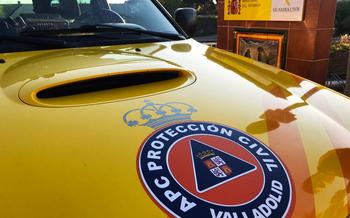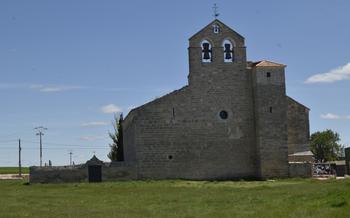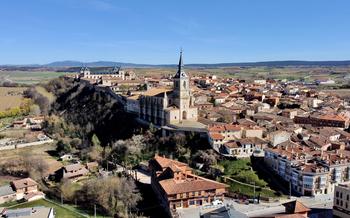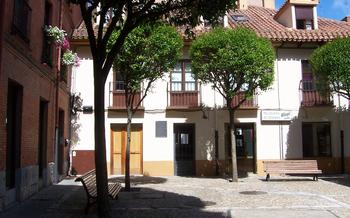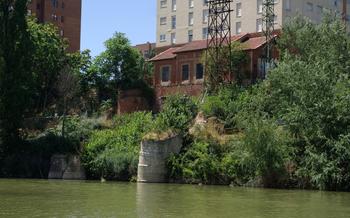
Ruta del Vino de Ribera del Duero (nearby attraction)
- A Journey Through Wine Country:
- Mapping the Route
- Unveiling Architectural Gems
- Exploring the Vineyards
- Savoring the Local Cuisine:
- Discovering Unique Wineries
- Indulging in Wine Tasting
- Learning about Winemaking
- Discovering Local Festivals and Events
- Exploring the Natural Wonders:
- Finding Unique Accommodation
- Planning a Memorable Trip
- Capturing the Beauty:
- Connecting with the Locals:
- Insider Tip: Unveiling the Hidden Treasure of Aranda de Duero
A Journey Through Wine Country:
In the heart of Castile and Leon, nestled between the Douro River and the imposing Sierra de Guadarrama, lies the Ribera del Duero, a region renowned for its exceptional wines. With a history dating back to the Middle Ages, this wine-growing region has earned a reputation for producing some of Spain's most prestigious and sought-after vintages.
The Ribera del Duero's unique terroir, characterized by a continental climate, poor soils, and an altitude ranging from 700 to 850 meters above sea level, creates an ideal environment for viticulture. The region's vineyards, primarily planted with the Tempranillo grape variety, thrive in these conditions, producing grapes with intense flavors and remarkable aging potential.
Winemaking in Ribera del Duero is a blend of tradition and innovation. Traditional techniques, such as hand-harvesting and aging in oak barrels, are still widely practiced, ensuring the wines retain their distinctive character. At the same time, modern winemaking technologies have been introduced, allowing producers to refine their techniques and create wines that are both elegant and complex.
Mapping the Route
The Ribera del Duero wine region is conveniently located in northwestern Spain, just a short distance from the city of Valladolid. The route winds its way through the provinces of Burgos, Valladolid, Segovia, and Soria, showcasing the diverse landscapes and cultural heritage of the region.
Major towns and villages along the route include Aranda de Duero, Peñafiel, and Roa, each offering its own unique charm and attractions. Aranda de Duero, the unofficial capital of the region, is home to numerous wineries and wine bars, as well as historical landmarks such as the Church of Santa María la Real. Peñafiel boasts an impressive castle that dominates the skyline, while Roa is known for its medieval architecture and its many wine cellars.
Transportation options for exploring the Ruta del Vino de Ribera del Duero are varied and convenient. Visitors can choose to drive along the scenic carreteras, taking in the breathtaking views of the vineyards and countryside. Alternatively, guided tours and wine tastings are available, providing a hassle-free and informative way to experience the region.
For those looking for a more immersive experience, a multi-day itinerary is recommended. This allows visitors to explore the region at a leisurely pace, savoring the local cuisine, visiting wineries, and discovering the many hidden gems that the Ruta del Vino de Ribera del Duero has to offer.
Unveiling Architectural Gems
The Ribera del Duero region is a treasure trove of architectural wonders, showcasing a diverse range of styles from Gothic to Renaissance and Mudejar. Explore the region's rich history through its architectural landmarks, each with its own unique story to tell.
Stroll through the cobblestone streets of imposing castles like Peñafiel Castle, which dominates the skyline with its formidable towers and battlements. Step inside the majestic churches, such as the Collegiate Church of Santa María la Mayor in Aranda de Duero, with its soaring Gothic vaults and intricate stained-glass windows. Admire the Mudejar style of the Church of Santiago Apóstol in Peñafiel, where Islamic and Christian influences blend harmoniously in its brickwork and ceramic details.
Embark on a self-guided walking tour to uncover hidden architectural gems or join a guided tour to delve deeper into the historical significance of these monuments. Let the stones whisper tales of the region's past as you wander through these architectural masterpieces.
Exploring the Vineyards
The Ribera del Duero region is renowned for its sprawling vineyards, which offer a picturesque landscape that changes with the seasons. In the spring, the vines burst into life with vibrant green leaves, while in the summer, they bear heavy clusters of ripening grapes. As autumn approaches, the leaves turn golden brown, creating a breathtaking tapestry of colors.
Beyond their aesthetic beauty, the vineyards hold immense importance for the region's wine industry. Sustainable viticulture practices are employed to ensure the long-term health of the vines and the environment. Winemakers in the region take pride in their craft, meticulously tending to their vineyards to produce grapes of exceptional quality.
A visit to the vineyards offers an opportunity to witness the daily life of winemakers and learn about their passion for their work. Visitors can take guided tours of the vineyards, where they can learn about the different grape varieties, soil types, and climatic conditions that contribute to the unique characteristics of Ribera del Duero wines. Some wineries also offer hands-on experiences, such as grape stomping or barrel tasting, for a truly immersive experience.
Savoring the Local Cuisine:
The Ribera del Duero region is a culinary paradise, offering a diverse range of traditional dishes that showcase the region's rich agricultural heritage. Lamb, a specialty of the region, is often roasted or grilled to perfection and served with a variety of accompaniments. Local cheeses, such as the creamy Queso Castellano, are a must-try, as are the fresh vegetables grown in the region's fertile valleys.
For a true taste of local flavors, venture into the region's tapas bars, where you can sample a variety of small plates, each representing a different aspect of the regional cuisine. From croquetas, filled with a creamy bechamel sauce, to patatas bravas, fried potatoes served with a spicy tomato sauce, there is something to satisfy every palate.
To navigate the menu, look for dishes that feature local ingredients, such as lamb, cheese, or seasonal vegetables. If you're unsure what to order, don't hesitate to ask for recommendations from the friendly staff. Be sure to try a glass of local wine to complement your meal and enhance the overall dining experience.
Discovering Unique Wineries
Along the Ruta del Vino de Ribera del Duero, a journey of discovery awaits wine enthusiasts, leading them to the doors of renowned wineries that have shaped the region's reputation. One such gem is Bodegas Protos, a trailblazer in the region, established in 192Its iconic building, designed by acclaimed architect Richard Rogers, seamlessly blends into the landscape, showcasing a profound respect for the environment. Visitors can immerse themselves in the winery's history through guided tours, marveling at its state-of-the-art facilities and learning about its commitment to sustainable viticulture. The experience culminates in a tasting of their exceptional wines, allowing visitors to savor the essence of Ribera del Duero in every sip.
Another must-visit winery is Bodegas Vega Sicilia, a legendary name in the world of wine. Founded in 1864, it is renowned for its meticulous attention to detail and its unwavering dedication to producing wines of unparalleled quality. Visitors can explore the winery's historic cellars, where barrels of aging wine rest in serene silence, and learn about the secrets behind their acclaimed vintages. A tasting of their wines, accompanied by knowledgeable sommeliers, offers a glimpse into the mastery and passion that define Bodegas Vega Sicilia.
Each winery along the route possesses its unique character and charm, inviting visitors to embark on a journey of discovery. From the modern architecture of Bodegas Portia to the traditional charm of Bodegas Emilio Moro, every stop offers a glimpse into the diverse facets of winemaking in Ribera del Duero. Whether it's a guided tour, a tasting session, or simply a chance to soak in the ambiance, each winery visit promises a memorable experience that will linger in the memory long after the journey's end.
Indulging in Wine Tasting
Wine tasting is an essential part of the Ribera del Duero experience. To truly appreciate the nuances and flavors of the region's wines, it is important to conduct a proper tasting. Start by swirling the wine in your glass to release its aromas. Then, take a deep sniff to identify the various fruit, floral, and spice notes. Finally, take a small sip and let the wine linger on your palate, allowing its flavors to develop and evolve.
There are different types of wine tastings available along the Ruta del Vino de Ribera del Duero. Guided sessions, led by experienced wine experts, offer a structured and informative experience. Self-guided tastings, on the other hand, allow visitors to explore at their own pace and choose the wines they want to try.
To enhance the tasting experience, pair your wines with local cheeses or tapas. The region's rich culinary tradition offers a variety of flavors that complement the wines perfectly. For a truly immersive experience, consider booking a wine and food pairing session at one of the local wineries.
Learning about Winemaking
Immerse yourself in the art of winemaking as you delve into the traditional techniques employed in the Ribera del Duero region. Discover how meticulous grape harvesting, careful fermentation, and aging in oak barrels contribute to the exceptional quality of the wines. Participate in hands-on activities like grape stomping or barrel tasting to gain a deeper understanding of the winemaking process. For those seeking a more comprehensive education, workshops and seminars are available, providing insights into the science and history of winemaking. Enhance your appreciation for the region's liquid gold as you learn about the passion and dedication that goes into each bottle.
Discovering Local Festivals and Events
The Ribera del Duero region is a vibrant hub of cultural festivities throughout the year. Immerse yourself in the local traditions by attending one of the many festivals and events that celebrate the region's wine, history, and heritage.
The highlight of the year is the Fiesta de la Vendimia, or Grape Harvest Festival, held in September. This exuberant celebration marks the beginning of the grape harvest season, with parades, music, dancing, and, of course, plenty of wine tasting.
Other notable events include the Feria del Vino de Cigales, a wine fair held in Cigales in May, showcasing the region's best vintages. In June, the Medieval Market of Peñafiel transports visitors back in time with its historical reenactments, craft stalls, and traditional music.
For a unique religious experience, attend the Procession of the Holy Burial in Valladolid during Easter week. This solemn procession features elaborate floats and hooded penitents, creating a mesmerizing spectacle.
Plan your trip to coincide with these events to immerse yourself in the region's vibrant culture and make your journey truly unforgettable. Don't forget to check local calendars or tourist information centers for the exact dates and details of these events.
Exploring the Natural Wonders:
Beyond the vineyards and wineries, the Ribera del Duero region boasts a diverse array of natural wonders that beckon outdoor enthusiasts. Rolling hills, lush forests, and tranquil waterways create a picturesque backdrop for exploration. For those seeking an active adventure, hiking trails and biking routes wind through the region, offering panoramic views and encounters with local wildlife. Birdwatchers and nature lovers can delight in the region's natural reserves, home to a variety of bird species and other wildlife. Don't miss the opportunity to visit scenic viewpoints or hidden waterfalls for breathtaking vistas of the countryside. Whether you prefer a leisurely stroll or a challenging hike, the natural beauty of the Ribera del Duero region is waiting to be discovered.
Finding Unique Accommodation
Along the Ruta del Vino de Ribera del Duero, travelers are spoiled for choice when it comes to accommodation. From charming bed and breakfasts nestled amidst vineyards to luxurious wine resorts offering exclusive experiences, there's something to suit every taste and budget.
Many of the accommodations in the region embrace the wine theme, offering amenities such as vineyard views, wine tastings, and wine-themed spa treatments. For a truly immersive experience, consider staying at a winery hotel, where you can learn about the winemaking process, tour the vineyards, and sample the estate's wines.
To ensure a comfortable and memorable stay, it's advisable to book your accommodation in advance, especially during the peak tourist season. This will allow you to secure your preferred choice and avoid any last-minute disappointments.
Personal Recommendation: For a truly unique experience, I highly recommend staying at the Abadía Retuerta LeDomaine, a stunning winery hotel located in the heart of the Ribera del Duero region. Set within a beautifully restored 12th-century monastery, the hotel offers luxurious accommodations, a world-class spa, and an exceptional wine cellar.
Planning a Memorable Trip
To make the most of your Ribera del Duero adventure, careful planning is essential. Consider the best time to visit based on your preferences. Spring (April-May) offers beautiful landscapes, while summer (June-August) is ideal for outdoor activities. Autumn (September-October) brings the vibrant colors of harvest season, and winter (November-March) offers a cozy charm with fewer crowds.
Create a personalized itinerary that aligns with your interests and budget. Decide on the must-see wineries, towns, and attractions. Allocate enough time for wine tasting, exploring the vineyards, and indulging in local cuisine. Consider booking guided tours or hiring a car for added flexibility.
Pack comfortable shoes for walking and exploring the uneven terrain of the vineyards. Dress in layers, as the weather can be unpredictable. Don't forget your camera to capture the stunning scenery and special moments.
Respect the local culture and customs. Learn a few basic Spanish phrases to communicate with the locals. Be mindful of local traditions and etiquette, such as greeting people with a handshake or a kiss on both cheeks.
Capturing the Beauty:
The Ribera del Duero region is a visual feast, offering endless opportunities to capture the essence of its beauty through photography. From the rolling vineyards that stretch to the horizon to the historic villages perched on hilltops, every corner of the region is a potential photo spot.
Suggested Photo Spots:
-
Vineyards: Capture the stunning landscapes of the vineyards, with rows of vines leading to distant hills. Look for opportunities to photograph the vineyards during different seasons, from the lush greenery of spring to the vibrant colors of autumn.
-
Historical Landmarks: The region is dotted with historical landmarks, such as castles, churches, and monasteries. These architectural gems provide a glimpse into the past and offer unique photo opportunities.
-
Local Life: Capture the essence of local life by photographing people going about their daily activities, such as working in the vineyards or enjoying a meal at a traditional restaurant. These candid shots will add a personal touch to your travel photos.
Tips for Taking Memorable Travel Photos:
-
Composition: Pay attention to the composition of your photos, considering elements such as lines, shapes, and colors. Use the rule of thirds to create a balanced and visually appealing image.
-
Lighting: Lighting is crucial for photography. Try to shoot during the golden hours (sunrise and sunset) when the light is soft and warm, creating a magical atmosphere.
-
Storytelling: Your photos should tell a story about your journey through the Ribera del Duero region. Capture moments that convey the region's culture, history, and beauty.
Connecting with the Locals:
The people of Ribera del Duero are warm and welcoming, eager to share their passion for wine and their rich cultural heritage. Interacting with locals is an essential part of experiencing the true essence of the region. Visit local markets, where vendors proudly display their fresh produce, handmade crafts, and regional specialties. Join in the lively atmosphere of festivals and celebrations, where locals dance, sing, and feast together. Attend wine-tasting events at wineries or local bars to meet winemakers and fellow enthusiasts, exchanging stories and insights about the region's liquid gold. Learning a few basic Spanish phrases, such as "Hola" (hello), "Gracias" (thank you), and "Por favor" (please), will go a long way in showing respect and fostering connections with the locals. Their warm hospitality and genuine smiles will make your journey through Ribera del Duero all the more memorable.
Insider Tip: Unveiling the Hidden Treasure of Aranda de Duero
Venture beyond the main route to discover the hidden gem of Aranda de Duero, a town nestled between vineyards and medieval walls. Explore the 13th-century castle, wander through the narrow cobblestone streets, and admire the Gothic and Renaissance architecture that adorns the town. Don't miss the opportunity to visit the Bodega Histórica Don Carlos, a 16th-century winery with underground cellars that house a treasure trove of aged wines. Immerse yourself in the town's rich wine culture, savor the local cuisine, and experience the warmth of its people. Aranda de Duero awaits those who seek an authentic and enchanting glimpse into the heart of Ribera del Duero.
